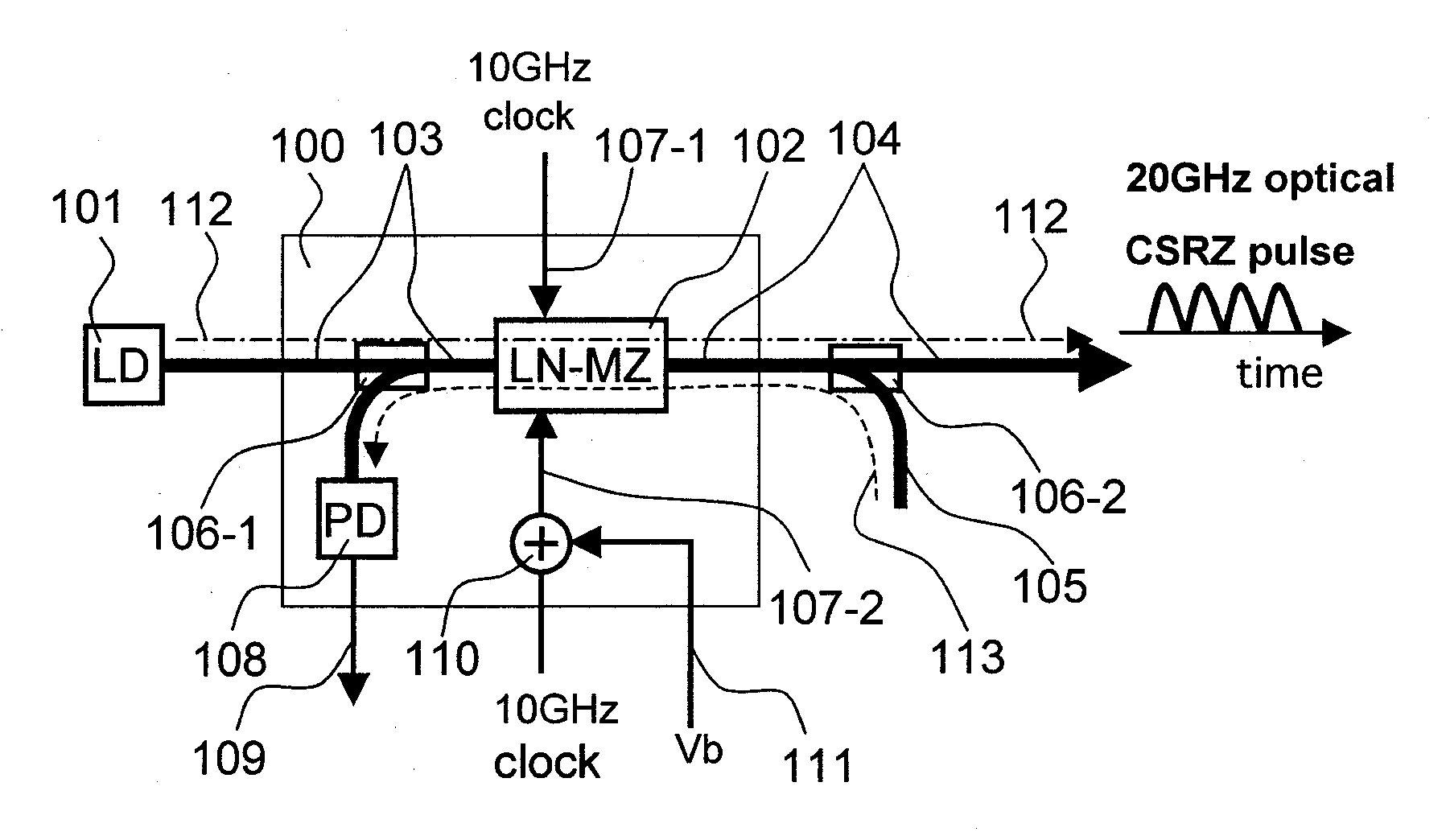Optical modulation device, optical transmitter, and optical transmission equipment
- Summary
- Abstract
- Description
- Claims
- Application Information
AI Technical Summary
Benefits of technology
Problems solved by technology
Method used
Image
Examples
first embodiment
[0063]FIG. 1 is a block diagram showing a first embodiment of this invention, which is an example where an optical modulation device 100 of this invention is applied for formation of the CSRZ optical pulse. The laser beam outputted from the laser optical source 101 advances along the path 112 of the signal light in the figure, is inputted into the optical modulator 102 from the light input path 103-1, and outputted as the CSRZ optical pulse from the light output path 104. As the optical modulator 102, a general dual-drive LN-MZ modulator is used, and the sinusoidal wave clock signals of a frequency of 10 GHz whose phases are mutually reversed are applied to the two traveling-wave type input terminals 107-1, 107-2. A generation principle of the CSRZ optical pulse is the same as that of the conventional example described above. A low-speed (direct current or about a few MHz at the highest) bias-voltage Vb is connected to the traveling-wave type input terminal 107-2 through a bias tee ...
second embodiment
[0073]FIG. 7 is a block diagram showing a second embodiment of this invention, which is an example where a part of the signal light is reflected by a reflecting mirror, this reflected light is used as the control light, and an automatic control circuit is disposed in the interior of the optical modulation device 100 of this invention. A reflecting mirror 130 is connected to the end of the control light input path 105 in FIG. 7A. By this, a part of the signal light (path 112-2) that is split to the control light input path 105 side by the optical coupler 106-2 is reflected, and transmitted in an opposite direction. Accordingly, this can be used as the control light. When the signal light is transmitted through the optical modulator 102 in a forward direction first, it is subjected to the CSRZ pulse modulation, and the average power at the optimal point will change with the clock amplitude, as shown in FIG. 6C. However, when this signal reverses the optical modulator 102 as the contro...
third embodiment
[0080]FIG. 9 is a block diagram showing a third embodiment of this invention, which is an example where a state of polarization of the control light is temporally scrambled using an electric control polarization controller to resolve the polarization dependency. This example is an example of using a loop type mirror that, by connecting an optical circulator 139 to a top of the control light input path 105 and further connecting optical fiber to the loop further ahead of this, the CSRZ optical signal inputted therein along the optical path 112-2 is made to go one round, drawn back to the original path, and used as the control light. An electric control polarization controller 134 is disposed in a part of the loop. This is used as a polarization scrambler on which a sinusoidal electrical signal of frequency f (for example, a few kHz to a few tens of kHz) obtained from a low-frequency sinusoidal-wave signal source 133 is applied and that reduces the degree of polarization of the contro...
PUM
 Login to View More
Login to View More Abstract
Description
Claims
Application Information
 Login to View More
Login to View More - R&D
- Intellectual Property
- Life Sciences
- Materials
- Tech Scout
- Unparalleled Data Quality
- Higher Quality Content
- 60% Fewer Hallucinations
Browse by: Latest US Patents, China's latest patents, Technical Efficacy Thesaurus, Application Domain, Technology Topic, Popular Technical Reports.
© 2025 PatSnap. All rights reserved.Legal|Privacy policy|Modern Slavery Act Transparency Statement|Sitemap|About US| Contact US: help@patsnap.com



